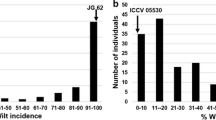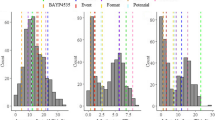Abstract
Ascochyta blight in chickpea (Cicer arietinum L.) is a devastating fungal disease caused by the necrotrophic pathogen, Ascochyta rabiei (Pass.) Lab. To elucidate the genetic mechanism of pathotype-dependent blight resistance in chickpea, F7-derived recombinant inbred lines (RILs) from the intraspecific cross of PI 359075(1) (blight susceptible) × FLIP84-92C(2) (blight resistant) were inoculated with pathotypes I and II of A. rabiei. The pattern of blight resistance in the RIL population varied depending on the pathotype of A. rabiei. Using the same RIL population, an intraspecific genetic linkage map comprising 53 sequence-tagged microsatellite site markers was constructed. A quantitative trait locus (QTL) for resistance to pathotype II of A. rabiei and two QTLs for resistance to pathotype I were identified on linkage group (LG)4A and LG2+6, respectively. A putative single gene designated as Ar19 (or Ar21d) could explain the majority of quantitative resistance to pathotype I. Ar19 (or Ar21d) appeared to be required for resistance to both pathotypes of A. rabiei, and the additional QTL on LG4A conferred resistance to pathotype II of A. rabiei. Further molecular genetic approach is needed to identify individual qualitative blight resistance genes and their interaction for pathotype-dependent blight resistance in chickpea.



Similar content being viewed by others
References
Ahmad GD, Hafiz A, Ashraf M (1952) Some studies on chickpea crosses. In: Proceedings of the 4th Pakistan science conference, Peshwar, 1952. Part IV. Scientific land utilization. Pakistan Association for the Advancement of Science, Lahore, pp 15–16
Chen W, Muehlbauer FJ (2002) A mini-dome technique for virulence assay of Ascochyta rabiei on chickpea. In: Proceedings of 4th Canadian pulse research workshop, Edmonton, Alberta, 8–10 December 2002, pp 167–171
Cho S, Kumar J, Shultz JL, Anupama K, Tefera F, Muehlbauer FJ (2002) Mapping genes for double podding and other morphological traits in chickpea. Euphytica 128:285–292
Dey SK, Singh G (1993) Resistance to ascochyta blight in chickpea—genetic basis. Euphytica 68:147–153
Flandez-Galvez H, Ades PK, Ford R, Pang ECK, Tayler PWJ (2003) QTL analysis for ascochyta blight resistance in an intraspecific population of chickpea (Cicer arietinum L.). Theor Appl Genet 107:1257–1265
Hafiz A, Ashraf M (1953) Studies on the inheritance of resistance to Mycosphaerella blight in gram. Phytopathology 43:580–581
Hervas A, Trapero-Casas JL, Jimenez-Diaz RM (1995) Induced resistance against fusarium wilt of chickpea by nonpathogenic races of Fusarium oxysporum f. sp. ciceri and nonpathogenic isolates of F. oxysporum. Plant Dis 79:1110–1116
Hüttel B, Winter P, Weising H, Choumane W, Weigand F, Kahl G (1999) Sequence-tagged microsatellite site markers for chickpea (Cicer arietinum L.). Genome 42:210–217
Jamil FF, Sarwar N, Sarwar M, Khan JA, Geistlinger J, Kahl G (2000) Genetic and pathogenic diversity within Ascochyta rabiei (Pass.) Lab. populations in Pakistan causing blight of chickpea (Cicer arietinum L.). Physiol Mol Plant Pathol 57:243–254
Kusmenoglu I (1990) Ascochyta blight of chickpea: inheritance and relationship to seed size, morphological traits, and isozyme variation. MS Thesis, Washington State University
Lander ES, Green P, Abrahamson J, Barlow E, Daly MJ, Lincoln SE, Newberg L (1987) MAPMAKER: an interactive computer package for constructing primary genetic linkage maps of experimental and natural populations. Genomics 1:174–181
Muehlbauer FJ (1996) Advances in the production of cool-season food legumes. Am J Altern Agric 11:71–76
Nelson JC (1997) QGENE: software for maker-based genomic analysis and breeding. Mol Breed 3:239–245
Roger C, Tivoli B, Huber L (1999) Effects of temperature and moisture on disease and fruit body development of Mycosphaerella pinodes on pea (Pisum sativum). Plant Pathol 48:1–9
Santra DK, Tekeoglu M, Ratnaparkhe M, Kaiser WJ, Muehlbauer FJ (2000) Identification and mapping of QTLs conferring resistance to ascochyta blight in chickpea. Crop Sci 40:1606–1612
Singh KB, Reddy MV (1983) Inheritance of resistance to ascochyta blight in chickpea. Crop Sci 23:9–10
Singh KB, Reddy MV (1996) Improving chickpea yield by incorporating resistance to ascochyta blight. Theor Appl Genet 92:509–515
Tekeoglu M, Santra DK, Kaiser WJ, Muehlbauer FJ (2000) Ascochyta blight resistance inheritance in three chickpea recombinant inbred line populations. Crop Sci 40:1251–1256
Tekeoglu M, Rajesh PN, Muehlbauer FJ (2002) Integration of sequence tagged microsatellite sites to the chickpea genetic map. Theor Appl Genet 105:847–854
Tewari SK, Pandey MP (1986) Genetics of resistance to ascochyta blight in chickpea (Cicer arietinum L.). Euphytica 35:211–215
Tuite J (1969) Plant phytopathological methods. Burgess, Minneapolis, p 239
Udupa SM, Baum M (2003) Genetic dissection of pathotype-specific resistance to ascochyta blight resistance in chickpea (Cicer arietinum L.) using microsatellite markers. Theor Appl Genet 106:1196–1202
Vir S, Grewal JS, Gupta VP (1975) Inheritance of resistance to Ascochyta rabiei in chickpea. Euphytica 24:209–211
Weising, K, Nybom H, Wolff K, Meyer W (1994) DNA fingerprinting in plants and fungi. CRC, Boca Raton, p 336
Winter P, Pfaff T, Udupa SM, Hüttel B, Sharma PC, Sahi S, Arreguin-Espinoza R, Weigand F, Muehlbauer FJ, Kahl G (1999) Characterization and mapping of sequence-tagged microsatellite sites in the chickpea (Cicer arietinum L.) genome. Mol Gen Genet 262:90–101
Winter P, Benko-Iseppon AM, Huttel B, Ratnaparkhe M, Tullu A, Sonnante G, Pfaff T, Tekeoglu M, Santra D, Sant VJ, Rajesh PN, Kahl G, Muehlbauer FJ (2000) A linkage map of the chickpea (Cicer arietinum L.) genome based on recombinant inbred lines from a C. arietinum × C. reticulatum cross: localization of resistance genes for fusarium wilt races 4 and 5. Theor Appl Genet 101:1155–116
Acknowledgements
The authors thank to Drs. A. Kleinhofs, S.S. Jones, L.A. Hadwiger, and V.R. Franceschi for critical discussion and manuscript review.
Author information
Authors and Affiliations
Corresponding author
Additional information
Communicated by C. Möllers
Rights and permissions
About this article
Cite this article
Cho, S., Chen, W. & Muehlbauer, F.J. Pathotype-specific genetic factors in chickpea (Cicer arietinum L.) for quantitative resistance to ascochyta blight. Theor Appl Genet 109, 733–739 (2004). https://doi.org/10.1007/s00122-004-1693-x
Received:
Accepted:
Published:
Issue Date:
DOI: https://doi.org/10.1007/s00122-004-1693-x




